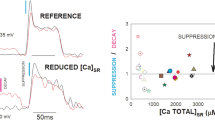Summary
The effects of low (10–100 μm) concentrations of tetracaine on intramembrane charge movement and on the rate of calcium release (Rrel) from the sarcoplasmic reticulum (SR) were studied in cut skeletal muscle fibres of the frog using the voltage clamp technique. The fibres were mounted in a single or double vaseline gap chamber to study the events near the contraction threshold or in a wide membrane potential range. Although the ‘hump’ component of charge movement (Qγ) was suppressed to some extent, the voltage dependence and the parameters of the Boltzmann distribution were not modified significantly at tetracaine concentrations below 50 μm. At 50 and 100 μm of tetracaine the midpoint voltage of the Boltzmann distribution was shifted to higher membrane potentials and the steepness was decreased. The total available charge remained the same at all concentrations tested. Using fura-2 to measure calcium transients at 100 μm tetracaine the threshold for calcium release was found to be significantly shifted to more positive membrane potentials. Tetracaine reversibly suppressed both the early inactivating peak and the steady-level of Rrel but the concentration dependence of these effects was markedly different. The inactivating component of calcium release was decreased with a Hill coefficient of approximately 1 and half effective concentration of 11.8 μm while the steady-level was decreased with a Hill coefficient of greater than 2 and a half effective concentration of 47.0 μm. These results favour two sites of action where tetracaine would suppress the calcium release from the SR.
Similar content being viewed by others
References
ANTONIUB., KIMD. H., MORIIM. & IKEMOTOM. (1985) Inhibitors of Ca release from the isolated sarcoplasmic reticulum. I. Ca channel blockers. Biochim. Biophys. Acta 816, 9–17.
BLOCKB. A., IMAGAWAT., CAMPBELLK. P. & FRANZINI-ARMSTRONGC. (1988) Structural evidence for direct interaction between the molecular components of the transverse tubule/sarcoplasmic reticulum junction in skeletal muscle. J. Cell. Biol. 107, 2587–600.
BULL, R. & MARENGO, J. J. (1990) Effects of tetracaine on calcium channels from sarcoplasmic reticulum. Biophys. J. 57, 343a.
BULLR. & MARENGOJ. J. (1993) Sarcoplasmic reticulum release channels from frog skeletal muscle display two types of calcium dependence. FEBS Lett. 331, 223–7.
CAPUTOC. (1972) The time course of potassium contractures of single muscle fibres. J. Physiol. 223, 483–505.
CSERNOCHL., HUANGC. L.-H., SZÜCSG. & KOVÁCSL. (1988) Differential effects of tetracaine on charge movements and Ca signals in frog skeletal muscle. J. Gen. Physiol. 92, 601–12.
CSERNOCHL., PIZARROG., URIBEI., RODRÍGUEZM. & RÍOSE. (1991) Interfering with calcium release suppresses Iγ, the delayed component of the intramembranous charge movement. J. Gen. Physiol. 97, 845–84.
CSERNOCHL., JACQUEMONDV. & SCHNEIDERM. F. (1993) Microinjection of strong calcium buffers suppresses the peak of calcium release during depolarization in frog skeletal muscle fibers. J. Gen. Physiol. 101, 297–333.
CSERNOCH, L., SÁRKÖZL, S., SZENTESI, P., KOVÁSC, L. (1996) Cardiac glycosides enhance calcium release from the sarcoplasmic reticulum of the frog. Biophys. J. 70, 167a.
ENDOM. (1985) Calcium release from the sarcoplasmic reticulum. Current Topics in Membrane Transport 25, 181–230.
GARCÍAJ., AVILA-SAKARA. J. & STEFANIE. (1991) Differential effects of ryanodine and tetracaine on charge movement and calcium transients in frog skeletal muscle. J. Physiol. 440, 403–17.
HUANGC. L.-H. (1980) Charge movement components in skeletal muscle. J. Physiol. 305, 31–2P.
HUANGC. L.-H. (1989) Intramembrane charge movements in skeletal muscle. Physiol. Rev. 68, 1197–247.
HUIC. S. (1982) Pharmacological studies of charge movement in frog skeletal muscle. J. Physiol. 337, 509–29.
KLEINM. G., SIMONB. J., SZÜCSG. & SCHNEIDERM. F. (1988) Simultaneous recording of calcium transients in skeletal muscle using high and low affinity calcium indicators. Biophys. J. 55, 971–88.
KOVÁCSL., RÍOSE. & SCHNEIDERM. F. (1983) Measurement and modification of free calcium transients in frog skeletal muscle fibers by a metallochromic indicator dye. J. Physiol. 343, 161–96.
LAIF. A., LIUQ.-Y., XUL., EL-HASHEMA., KRAMARCYN. R., SEALOCKR. & MEISSNERG. (1992) Amphibian ryanodine receptor isoforms are related to those of mammalian skeletal and cardiac muscle. Am. J. Physiol. 263, C365–72.
MELZERW., RÍOSE. & SCHNEIDERM. F. (1984) Time course of calcium release and removal in skeletal muscle fibres. Biophys. J. 45, 637–41.
MELZERW., RÍOSE. & SCHNEIDERM. F. (1986) The removal of myoplasmic free calcium following calcium release in frog skeletal muscle. J. Physiol. 372, 261–92.
OLIVARESE. B., TANKSLEYS. J., AIREYJ. A., BECKC., OUYANGY., DEERINCKT. J., ELLISMANM. H. & SUTKOJ. L. (1991) Nonmammalian vertebrate skeletal muscles express two triad junctional foot protein isoforms. Biophys. J. 59, 1153–63.
PIZARROG., CSERNOCHL., URIBEI., RODRIGUEZM. & RÓSE. (1991) The relationship between Qγ and Ca release from the sarcoplasmic reticulum in skeletal muscle. J. Gen. Physiol. 97, 913–47.
PIZARROG., CSERNOCHL., URIBEI. & RÍOSE. (1992) Differential effects of tetracaine on two kinetic components of calcium release in frog skeletal muscle fibres. J. Physiol. 457, 525–38.
RÍOSE. & PIZARROG. (1988) Voltage sensors and calcium channels of excitation-contraction coupling. NIPS 3, 223–7.
SÁRKÖZIS., SZENTESIP., JONAI. & CSERNOCHL. (1996) Effects of cardiac glycosides on excitation-contraction coupling in frog skeletal muscle fibers. J. Gen. Physiol. 495, 611–26.
SZÜCSG., CSERNOCHL., MAGYARJ. & KOVÁCSL. (1991) Contraction threshold and the ‘hump’ component of charge movement in frog skeletal muscle. J. Gen. Physiol. 97, 897–911.
TINKER, A. & WILLIAMS, A. J. (1993) Charged local anaesthetics block the sheep cardiac ryanodine receptor-channel. Biophys. J. 64, 302a.
VERGARAJ. & CAPUTOC. (1983) Effects of tetracaine on charge movements and calcium signals in frog skeletal muscle fibres. Proc. Natl Acad. Sci. USA 80, 1477–81.
XUL., JONESR. V. & MEISSNERG. (1993) Effects of local anesthetics on single channel behavior of skeletal muscle calcium release channel. J. Gen. Physiol. 101, 207–33.
Author information
Authors and Affiliations
Rights and permissions
About this article
Cite this article
Sárközi, S., Szentesi, P., Cseri, J. et al. Concentration-dependent effects of tetracaine on excitation-contraction coupling in frog skeletal muscle fibres. J Muscle Res Cell Motil 17, 647–656 (1996). https://doi.org/10.1007/BF00154059
Received:
Revised:
Accepted:
Issue Date:
DOI: https://doi.org/10.1007/BF00154059




